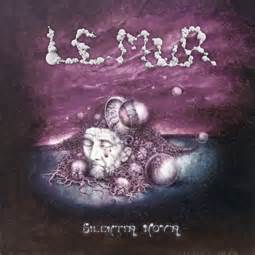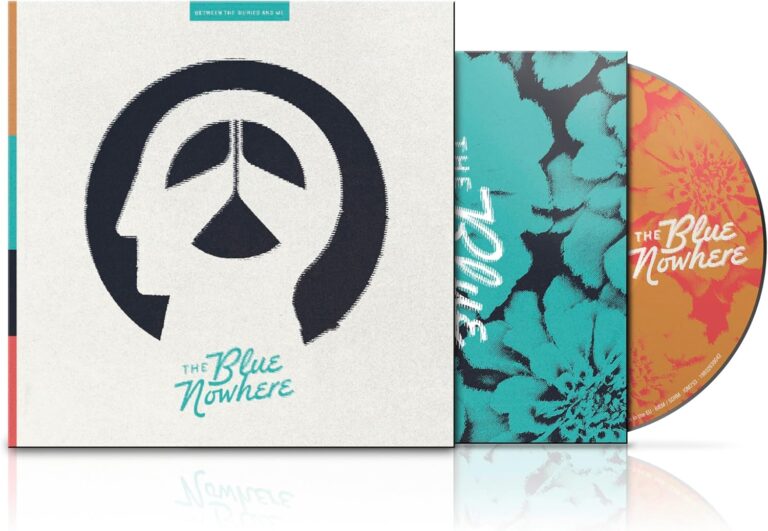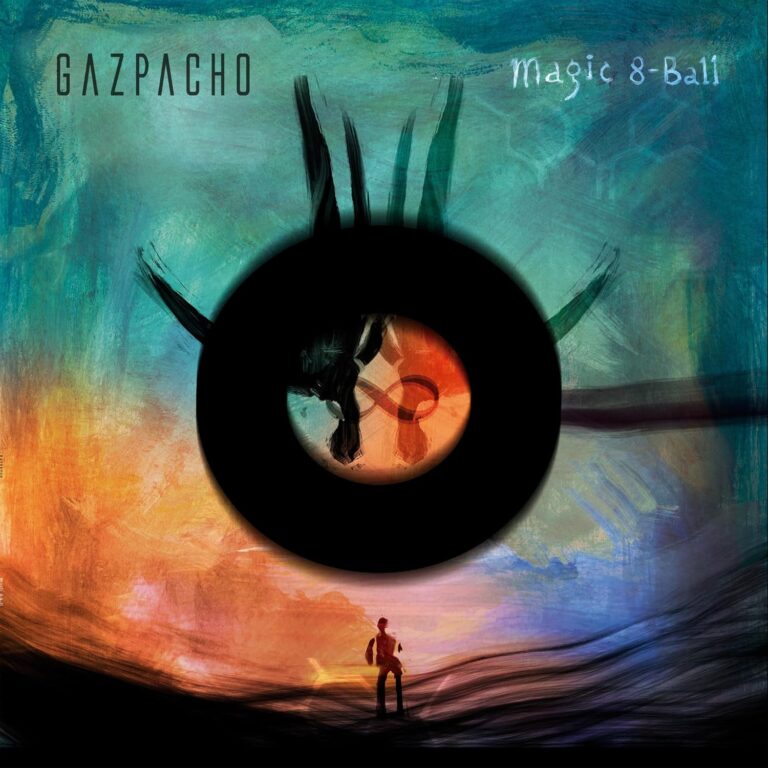 Le Mur were always a band who belonged on vinyl. The warm crackle of well-worn grooves just fits with the gloriously analogue atmosphere the band evoke, so the arrival of new album, ‘Silentia nova’, on beautiful red vinyl housed in a stunning gate-fold sleeve is very much welcome indeed. The two primary arguments for a vinyl pressing are sound (of course) and artwork. Those who read SonicAbuse with any regularity may have seen an interview with Roine Stolt of the Flower Kings recently (you missed that? It’s here) in which he lamented the move from vinyl to CD because it resulted in the shrinking of the artwork, previously a hugely important part of the album package, and thus reduced its importance. For Le Mur, however, the artwork is of immense importance and for this album the band employed the amazing artist Helmut Wenske to provide the stunning, psychedelic cover. The gatefold, meanwhile, offers one of those timeless band pictures which, if it weren’t for the state-of-the-art studio monitors in the background, could easily have been taken in the early seventies. The second essential element, the sound, is not only brilliantly realised here, it sees Le Mur heading ever further into the dark pastures carved out on their debut (still officially unreleased) LP, ‘In Tenebris’, which saw the band flirt with Hawkwind, Mogwai, Karma to burn and more whilst simultaneously developing their own identity. The production (handled by the band themselves) is just perfect and the way the warm bass flows from the speakers lets you know that this will never sound better than on vinyl. Musically, meanwhile, this, the second in trilogy the band have planned, is a step forward from what was already quite brilliant, and once more it is a pleasure to slip into the spacey world that La Mur create with seeming ease.
Le Mur were always a band who belonged on vinyl. The warm crackle of well-worn grooves just fits with the gloriously analogue atmosphere the band evoke, so the arrival of new album, ‘Silentia nova’, on beautiful red vinyl housed in a stunning gate-fold sleeve is very much welcome indeed. The two primary arguments for a vinyl pressing are sound (of course) and artwork. Those who read SonicAbuse with any regularity may have seen an interview with Roine Stolt of the Flower Kings recently (you missed that? It’s here) in which he lamented the move from vinyl to CD because it resulted in the shrinking of the artwork, previously a hugely important part of the album package, and thus reduced its importance. For Le Mur, however, the artwork is of immense importance and for this album the band employed the amazing artist Helmut Wenske to provide the stunning, psychedelic cover. The gatefold, meanwhile, offers one of those timeless band pictures which, if it weren’t for the state-of-the-art studio monitors in the background, could easily have been taken in the early seventies. The second essential element, the sound, is not only brilliantly realised here, it sees Le Mur heading ever further into the dark pastures carved out on their debut (still officially unreleased) LP, ‘In Tenebris’, which saw the band flirt with Hawkwind, Mogwai, Karma to burn and more whilst simultaneously developing their own identity. The production (handled by the band themselves) is just perfect and the way the warm bass flows from the speakers lets you know that this will never sound better than on vinyl. Musically, meanwhile, this, the second in trilogy the band have planned, is a step forward from what was already quite brilliant, and once more it is a pleasure to slip into the spacey world that La Mur create with seeming ease.
As with the previous record, spontaneity is key. Whilst it may well be the case that Le Mur plan every move they make, the sound is as thrillingly alive as the great jazz records of 1959 (‘Mingus Ah Um’, ‘kind of blue’ and ‘time out’ were all released that year) and listening to this pristine recording you feel as if you’re sitting in the studio as the band work out each moment for themselves. It’s a joy, in these days of studio-bound perfection, to hear a record that makes you feel that you’re present at its inception, rather than witnessing a digitally recorded and heavily sanitised representation that has been filtered through endless, soulless gadgets by an engineer whose primary job seems to be to make the music sound like everything else out there. Trust me, Le Mur sound like nothing else out there. The first track, ‘O.m.e.n – a decision of despair’ exists in a jazzier realm than seen on the previous record. Opening with the percussion riding high over delicate and spacious guitar lines, the band instantly welcome you back to their world, not with a bang, but with an insidious skill, a shadowy finger beckoning you ever deeper into the record’s interior. A lone guitar figure appears in the midst of this Twin Peaks worshipping weirdness, planting a solo that snakes its way through the spaces left by the slow riffs, and only the bass seems omnipresent through all this. All of a sudden the track changes pace the guitars frothing and sparking their way to a climax that feels like you’re a passenger, accelerating through the unfamiliar beauty of space. The scenery is now flying past as a bank of stuttering synths splutter into life and suddenly you’re into the heavily Kraftwerk influenced ‘technical progress and other suicide stuff’, the minimalist grind of which draws from David Bowie, Suicide, the aforementioned Kraftwerk and Syd Barrett-era Pink Floyd. The third track (uncredited) sees the band adopt a soulful posture via the unexpected addition of the saxophone (handled by the multi-talented Matthias Graf who also provides vocals, guitar and organ) and a bouncy ska-ish bass line that adds further depth to the band’s stylistic canon. ‘Die Nacht der Lemuren (Teil II)’ develops the sound and feel of the previous track further but swaps the sensual saxophone line for the haunting sound of a Hammond organ as if The Doors had been composing music under the influence of LSD, endless re-runs of The lost boys and a stack of LPs by the Specials and Madness.
Side two opens with ‘sun’, a track that hauls itself out of the hypnotic patterns of the wonderful Georgois Dosis, via the slinky bass work of Janine Ficklscherer and echoing feedback of Matthias to draw a line between early Sonic Youth and The Velvet Underground’s darkly influential debut LP. All ambient noise and muttered vocals slithering out of the darkness, the track suddenly explodes into frazzled life with the guitars blazing a trail through the twilight as Georgios attacks his kit like a man possessed. Elements of primitive New York indie are present here, as are touches of minimalist composer Glenn Branca and you start to realise just how wide and varied the joint record collection of the band must surely be. The title track opens in a similar vein to Pink Floyd’s masterly ‘set the controls for the heart of the sun’, a subtle yet menacing guitar line backed by semi-audible vocals and echoing noise, only Le Mur move deftly from art rock into funk territory (no really) via a springy bass line that is as brilliant in conception as it is unexpected. No one else makes music as beautifully off the wall as this and the result is that you’re drawn in ever deeper, always wanting to know what will happen next. What happens next, in this case, is the band drift into a skilful blend of rock and dub – a sound best described as Sonic Youth playing Dreadzone covers – and the song exits to the sound of a church organist being slowly rendered unconscious by hallucinogenic gasses mid performance. The closing track, ‘O.m.e.n – creation of a new silence’ sees the album out on a patchouli-scented high, all throbbing bass and jazzy guitar breaks that owes as much to the hard-rocking ambitions of latter-day Miles Davis as it does to Tony Iommi’s brutal power-chords and thirteenth floor elevators. It’s an amazing album closer, a wild-eyed trip to the very brink of madness that only allows you to return to normality when you hear the familiar click of the needle traversing the run off groove.
Le Mur suffered a set-back that might have killed a lesser band when their debut LP was held up to the point of not appearing at all. It is fortunate, then, that the band are driven by artistic rather than commercial concerns and that, in Tribal Stomp, the band have finally found a record label that understands the nature of their music. In the interim the band have become even better than their debut suggested, embracing an ever-wider range of musical influences to deliver a sound that is unique, enthralling and quite remarkable. It is an absolute joy to hear a band eschewing the labour-saving, talent-draining devices of the 21st Century to craft music that is as timeless as it is inspired and to sit and listen to this pristine vinyl recording is to be transported back by quite some years (more than I might care to count) to a time when music was more than just a disposable track on some internet based media server. Le Mur’s music is a thing of wonder and imagination and as such it can genuinely be called art. Long may the band live, evolve and thrive, for their music makes me remember exactly why I started writing music reviews in the first place.




